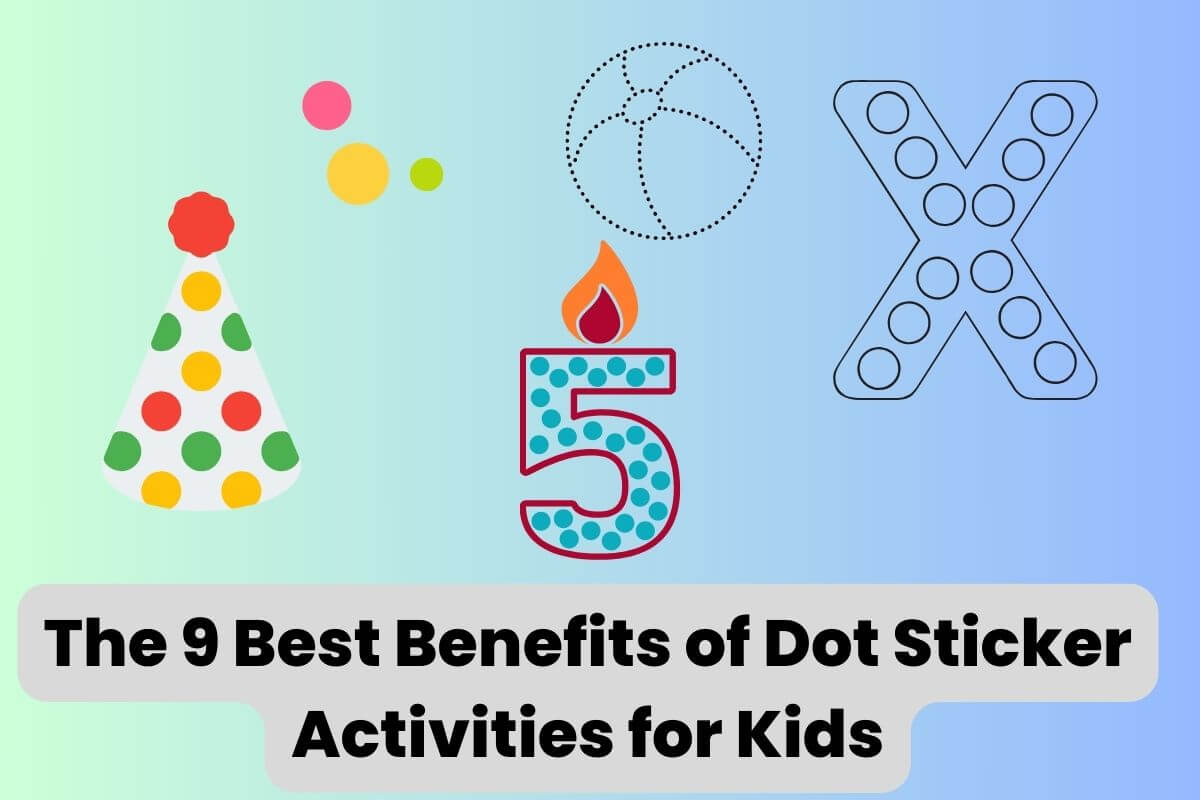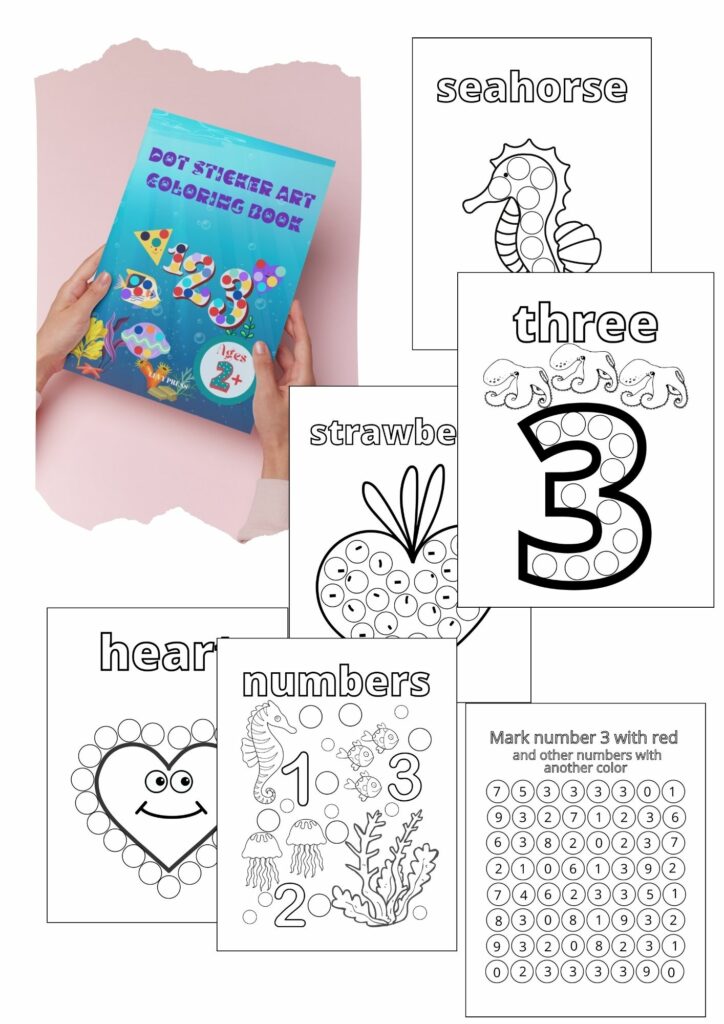
Why do we love dot sticker activities?
- They are super colorful
- Little hands can easily peel them off
- They make a versatile learning tool
- Large packs are pretty inexpensive, and you can buy them anywhere
Above all these, playing with dot stickers may help children with a variety of skills! What catches your eye when you see a sheet of dot stickers? Perhaps it’s the brightest dot sticker on the sheet, or perhaps it’s a unique character. Whatever makes you happy with dot stickers, they are all beneficial in developmental areas.
Note: Affiliate links may be used in this page. I may receive a small commission at no extra cost to you if you use my affiliate link. Full disclosure policy here.
9 Reasons Why EVERY Kid Should Do Dot Sticker Activities:
Neat pincer grasp:
Stickers are an excellent motor powerhouse. Peeling the sticky small graphics necessitates a precise pincer grasp to lift the edge of a sticker off a sticker sheet. To hold such a small space, the very tips of the fingers are required. It might be challenging for some children to hold only the edge of a single sheet of paper. Working with stickers is an excellent approach to hone your pincer grasp for tasks such as picking up little beads, string, or a sewing needle.
Peel stickers of various sizes to practice precise pincer grip. Smaller stickers are harder to remove. Place stickers on strips of masking tape and other surfaces, then peel them off. Then, practice grip by placing the stickers on various surfaces. To encourage an effective wrist posture, place the stickers on paper affixed to a wall.
Bilateral Hand Coordination:
It is a necessary ability for so many practical jobs. Activities requiring bilateral hand coordination include zippering a coat, cutting with scissors, and scribbling. Peeling stickers necessitates the use of both hands, since you must hold the sheet with one hand and peel with the dominant hand. Both hands are working and performing various activities.
Using very huge pieces of paper and very little sheets of paper, use stickers to practice bilateral hand coordination. Show your youngster different ways to hold the sticker sheet.
Spatial Awareness:
Difficulties with spatial awareness can make reading, writing, and doing all daily chores difficult. Children may have poor handwriting or difficulty arranging their bodies in space. Stickers can be used as a visual signal for spatial awareness.
Kids may notice the bright color of the sticker and use it as a visual indication for where to start writing on a paper, how large to form letters, where to stop in the locker corridor, where to put files in a desk, and where to put jackets in the closet. The possibilities for using stickers in this area are endless!
Place stickers on the left margin of a piece of paper for children who need assistance writing. Stickers can also serve as a guide for text size. Stick stickers on chairs, walls, and floors to create a large-scale labyrinth. While practicing spatial awareness, children can hop or leap over stickers, travel around them, and touch them.
Sensory Exploration:
Scratch and sniff stickers allow you to experiment with different fragrances. Discover the smooth, puffy, scratchy, and fuzzy textures of stickers. Stickers are also incredibly motivating for children. A sticker might be given to a youngster as a reward for touching a messy sensory bin or participating in arduous therapeutic treatment exercises.
Stickers can be used to practice proprioception in the hands. Stickers can be used in a mess-free sensory play activity. Stickers may be used in Occupational Therapy to help children improve a variety of skills such as fine motor, gross motor, visual perception, handedness, and more.
Handedness:
Kids frequently have difficulty determining which hand is whose. When writing, they will swap hands and may put their shoes on the incorrect foot. Use stickers as a visual indication for learning left from right, both on and off their body. A single sticker can be applied to a single shoe to assist a kid in learning to put their shoes on the right foot. To educate a youngster which way is up, place a sticker on the top of their coat.
Place a sticker on the side of the paper that the youngster should hold when learning scissor skills.
Body Awareness:
Toddlers may practice naming their body parts by affixing stickers to their feet and other body parts. Children who struggle with sequencing may have difficulties determining whether a sock or shoe goes on first. Stickers can aid with organization and placement on the body.
Stickers should be placed on the feet, hands, arms, and back. Request that your youngster touch particular body parts in a specified order. Improve your speed. Toddlers can practice naming body parts by attempting to peel off a sticker that has been applied to their wrist while you repeat “wrist.”
Alteration of the two sides of the hand:
Separation of the two sides of the hand is defined by using the thumb side of the hand while bending the pinkie side of the hand in stability. This is required for tripod grasp, in-hand manipulation, gross grasp, and power grip strength. Work on using stickers by placing one in the child’s hand. They may cover up the sticker by bending the pinkie, ring, and middle fingers down while utilizing the pointer and thumb for fine motor activities.
Place a tiny item, such as a cotton ball, in your hand and pick up stickers with your thumb and pointer finger. Stack stickers by stacking them on top of one another. Apply a sticker on the tip of a pencil to teach children where to squeeze the pencil when singing a tripod hold.
Hand Strength:
How can something as little as a sticker have an effect on hand strength? Children require power in the little muscles of their hands to draw, use an open web area while holding a pencil, and manage buttons and snaps on clothes. By removing stickers off resistant surfaces, children may strengthen their intrinsic hand muscles.
Place stickers on fabric, such as sofas or carpeting, and instruct your youngster to remove the stickers without ripping them. To lift them up, they will need to employ their intrinsic muscles and distinct hand arches.
Gross Motor Development:
Crossing the midline, leaping, hopping, skipping, and jumping jacks are all gross motor movements that some children find challenging. When training these areas, use stickers as a visual indication or a barrier.
Stick a sticker on each knee. Ask your youngster to touch the sticker on their right knee with their left hand and the sticker on their left knee with their right hand. Stick stickers on the walls as they try to jump up and touch them with their outstretched hands.
MORE REASONS TO PLAY WITH STICKERS:
Literacy, organization, sequencing, problem solving, self-esteem, language development, arithmetic, creativity, sense of achievement, stress reduction, goal setting, and socialization.
So, get your youngster interested in sticker collecting to help them with all of their developmental needs. You’ll also be able to relive your childhood with scratch-and-sniff, fuzzy, holographic, and puffy stickers!

Dot Sticker Art Coloring Book for kids ages 2+: Numbers, Shapes, Sea Animals